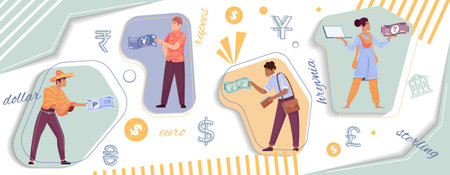1. Understanding the Emotional Side of Debt
When it comes to managing money, debt isn’t just about numbers—it’s deeply tied to our emotions and mindset. In American culture, debt can trigger powerful feelings like shame, stress, and even denial. Many people find it difficult to talk about their financial struggles, fearing judgment from family and friends. This sense of shame often leads to secrecy, making it harder to seek help or face the reality of one’s financial situation. Stress is another common emotion linked to debt; constant worry about bills and credit scores can affect everything from sleep quality to relationships. Denial also plays a major role—ignoring statements or avoiding conversations about money might provide temporary relief, but it usually makes things worse in the long run. Understanding these emotional drivers is the first step toward changing your money mindset for good. By recognizing how these feelings shape your decisions and behaviors around spending and debt management, you can begin to break free from negative cycles and move towards a healthier financial future.
2. Identifying Your Money Beliefs
Understanding the psychology of debt starts with recognizing your underlying beliefs about money. Many Americans grow up absorbing certain messages—sometimes without even realizing it—that can strongly influence their financial decisions as adults. These beliefs, often passed down from family or shaped by cultural norms, can either empower us to make healthy choices or trap us in cycles of debt and stress.
Common American Money Beliefs and Their Impact
| Belief | Typical Origin | Potential Impact |
|---|---|---|
| “Money is the root of all evil.” | Religious or cultural upbringing | Makes you feel guilty for wanting wealth, leading to self-sabotage or avoidance of financial planning. |
| “Talking about money is taboo.” | Family dynamics, societal norms | Prevents open conversations, making it hard to seek help or learn healthy habits. |
| “Debt is a normal part of life.” | Consumer culture, advertising | Encourages overspending and accepting high-interest debt as unavoidable. |
| “I’ll never be good with money.” | Past experiences, lack of education | Leads to resignation, procrastination, and missed opportunities for improvement. |
| “If I make more, I’ll be happy.” | Media influence, societal expectations | Keeps you chasing higher income instead of focusing on budgeting and mindful spending. |
How These Beliefs Shape Your Financial Choices
Your beliefs act like a filter, coloring every decision you make—from how much you spend on daily expenses to whether you reach out for help when facing debt. For example, if you grew up hearing that “credit cards are dangerous,” you might avoid building credit altogether; conversely, believing “everyone has debt” could lead you to take on loans without a clear plan to pay them off.
Why Self-Awareness Matters in Changing Your Mindset
The first step toward transforming your relationship with money is identifying which beliefs are serving you—and which ones are holding you back. Take a moment to reflect: Where did your core ideas about money come from? Are they rooted in facts and experience, or in outdated advice and fear? By bringing these subconscious patterns into the light, you give yourself the power to choose new beliefs that support your financial well-being for good.

3. Recognizing Debt Triggers and Spending Habits
Understanding what leads you into debt is a powerful first step toward financial freedom. In the U.S., our spending habits are often shaped by more than just personal choice—they’re influenced by social pressure, advertising, and even our upbringing. Let’s take a closer look at how these factors can push us into the cycle of debt, and how becoming aware of them can help you break free.
Habits: The Invisible Drivers
Daily routines like grabbing coffee on your commute or using credit cards for small purchases may seem harmless, but over time, they add up. Many Americans use “retail therapy” as a way to cope with stress or boredom, turning spending into an emotional habit rather than a conscious decision. Recognizing when you’re shopping out of habit instead of necessity is the first step to regaining control.
Social Pressure: Keeping Up With the Joneses
Living in a consumer-driven society means there’s often an underlying pressure to match the lifestyles of friends, family, or even strangers on social media. From driving the latest car to vacationing in trendy destinations, this “keeping up with the Joneses” mentality can lead to overspending and unnecessary debt. Remember: Everyone’s financial situation is different, and appearances rarely tell the whole story.
Lifestyle Inflation: The Sneaky Debt Trap
When you get a raise or bonus, it’s tempting to upgrade your life—nicer apartment, fancier dinners, new gadgets. This phenomenon is called lifestyle inflation, and it’s one of the most common reasons why increased income doesn’t always lead to greater savings. Instead, expenses rise in tandem with earnings, keeping you stuck in the same financial rut. Be mindful of how your spending changes as your income grows.
Taking Action: Awareness Leads to Change
The good news? Once you recognize your debt triggers and spending patterns, you can start making intentional choices. Keep a spending journal for a month or use budgeting apps to track where your money goes. Discuss money openly with trusted friends or family members—sometimes just talking about your habits brings clarity and accountability.
Your Mindset Matters
Shifting from autopilot spending to mindful money management is key to breaking the debt cycle. By understanding your unique triggers and embracing a proactive approach, you’ll not only avoid unnecessary debt but also set yourself up for long-term financial wellness.
4. Shifting Your Money Mindset
If youve ever felt overwhelmed by debt, youre not alone. The way we think about money—and especially debt—can significantly influence our financial behaviors. Shifting your money mindset is not about ignoring reality, but about reframing negative thoughts, practicing self-compassion, and setting achievable goals for a brighter financial future.
Reframing Negative Thoughts About Debt
Negative self-talk can make debt feel like an insurmountable obstacle. Instead of labeling yourself as “bad with money” or “irresponsible,” try to view debt as a temporary challenge and a learning opportunity. Here’s how you can start:
| Negative Thought | Reframed Perspective |
|---|---|
| I’ll never get out of debt. | This is tough, but every small payment gets me closer to financial freedom. |
| I’m terrible with money. | I’m learning new skills and making better choices every day. |
| My situation is hopeless. | Many people have overcome debt—I can do it too, one step at a time. |
Cultivating Self-Compassion
It’s easy to beat yourself up over past financial mistakes, but guilt and shame rarely lead to lasting change. Practice self-compassion by treating yourself with the same understanding you’d offer a friend in a similar situation. Remember, everyone makes mistakes, and each step you take toward improvement counts.
Quick Self-Compassion Exercise
- Acknowledge your feelings without judgment (“I feel stressed about my credit card balance”).
- Remind yourself that setbacks are part of the process (“Many Americans face similar challenges”).
- Commit to one positive action today (“I’ll review my budget after dinner”).
Setting Realistic Financial Goals
Big dreams are great, but progress comes from breaking them into smaller, realistic goals that keep you motivated. Start by identifying what matters most—whether it’s paying off a specific credit card, building an emergency fund, or saving for a big purchase. Then, outline actionable steps you can track month by month.
| Goal | Action Step | Timeline |
|---|---|---|
| Pay off $1,000 in credit card debt | Increase monthly payment by $50 | 20 months |
| Save $500 for emergencies | Set aside $20 each week | 6 months |
| Create a budget and stick to it | Track spending using an app | Review weekly |
Your Mindset Matters More Than You Think!
The journey toward financial wellness starts in your mind. By reframing negative thoughts, showing yourself compassion, and setting clear goals, you’ll be empowered to tackle debt—and transform your relationship with money for good.
5. Building Healthy Financial Behaviors
One of the most empowering ways to break free from debt is to develop positive, sustainable money habits. The journey starts with small, practical steps that gradually transform your relationship with money—moving you from reactive spending to proactive planning. Let’s explore some proven strategies Americans use to build healthy financial routines and take control of their finances for good.
Start with Simple Money Routines
Begin by setting up a consistent routine for checking your finances. This could be as simple as reviewing your bank account every Monday morning or setting aside 10 minutes each week to look at your credit card balances. Regular check-ins make it easier to spot unhealthy patterns and celebrate progress, building confidence along the way.
Track Your Spending Honestly
The next step is tracking where your money actually goes. Use whatever method feels natural—some people prefer apps like Mint or YNAB (You Need A Budget), while others jot expenses down in a notebook or spreadsheet. The key is to capture every dollar, even the small stuff like coffee runs or streaming subscriptions. Seeing your spending in black and white can be eye-opening and helps identify areas for improvement.
Leverage Budgeting Tools
Budgeting doesn’t have to feel restrictive—it’s about giving yourself more choices, not fewer. Many Americans find success using popular budgeting tools such as EveryDollar or Goodbudget, which make it easy to plan ahead and set personalized goals. These platforms often offer features that alert you when you’re close to overspending in a category or remind you of upcoming bills, reducing stress and helping you stay accountable.
Automate Good Habits
Consider automating positive behaviors wherever possible. Setting up automatic transfers into savings or making minimum payments on debts ensures you never miss a step, even during busy weeks. Automatic bill pay is especially popular in the U.S., freeing up mental space so you can focus on building wealth instead of worrying about due dates.
Remember, building healthy financial behaviors isn’t about perfection—it’s about progress. By embracing practical routines, tracking spending honestly, and using smart tools, you’ll create a strong foundation for lasting change and a brighter financial future.
6. Seeking Support and Accountability
Overcoming debt isn’t just about numbers—it’s about mindset and the people who support you on your journey. In the United States, there are abundant resources to help you break free from the psychological hold of debt and create lasting change in your financial life.
Understanding the Power of Community
No one should face financial challenges alone. Joining a supportive community, whether it’s an online forum, a local meetup, or a faith-based group, can provide encouragement and practical tips. Groups like Debtors Anonymous or online platforms such as Reddit’s r/personalfinance offer a safe space to share experiences, celebrate wins, and learn from others who have walked the same path.
Professional Guidance Makes a Difference
If you’re feeling overwhelmed by debt, consider reaching out to a certified financial counselor or advisor. Many non-profit organizations in the U.S., such as the National Foundation for Credit Counseling (NFCC), offer low-cost or even free counseling sessions. These professionals can help you develop a personalized action plan, negotiate with creditors, and most importantly—hold you accountable to your goals.
Leverage Financial Education Resources
The U.S. is rich with accessible financial education programs. Public libraries, community colleges, and even employers often host free workshops on budgeting, credit management, and investing. Websites like MyMoney.gov and Consumer Financial Protection Bureau (CFPB) provide trustworthy information and tools tailored to all stages of your financial journey.
Building Your Own Support Network
Surround yourself with people who understand your goals and want to see you succeed. This could be a trusted friend willing to check in on your progress, a family member who shares your commitment to financial wellness, or a mentor who has overcome similar struggles. Remember: accountability doesn’t mean judgment—it means encouragement and honest feedback when you need it most.
Tapping into community support, seeking professional advice, and taking advantage of educational resources empowers you to rewrite your money story for good. With the right support system in place, changing your money mindset becomes not just possible—but sustainable for life.

